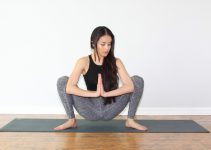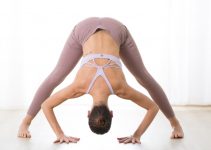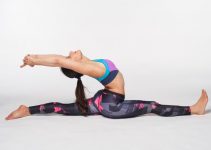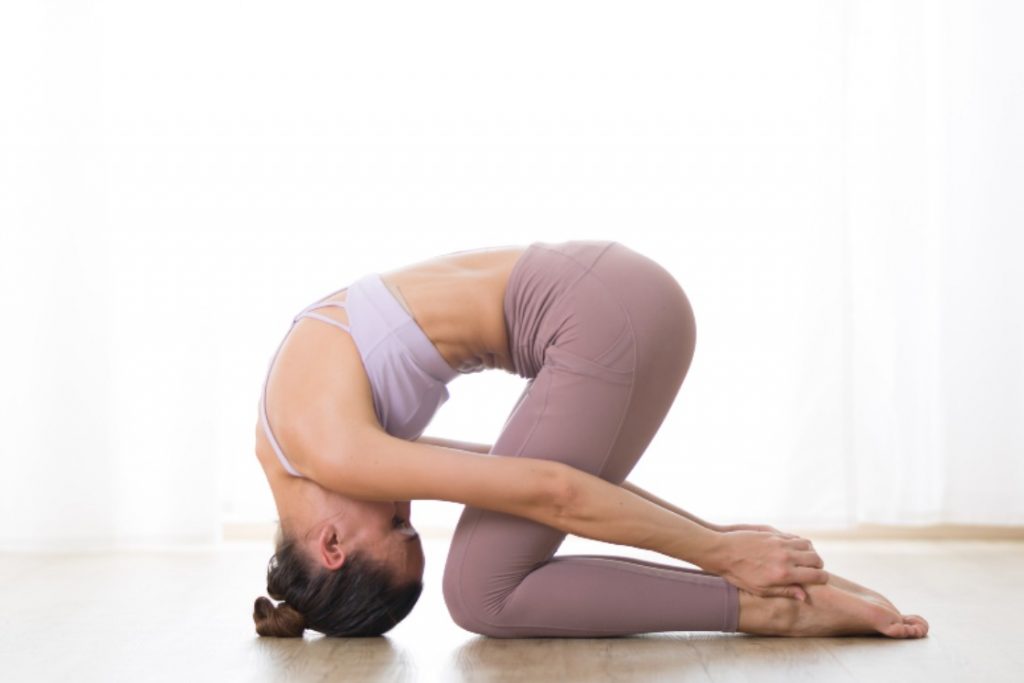
Rabbit Pose is a relaxing posture. In Bikram yoga, it’s practiced as one of the endings poses to which brings a calming effect to the body.
It is performed sitting on the heels including inversion and forward bending followed by stretching the body.
Taking balasana as a foundational pose, to come into the rabbit pose, the hands are brought to the feet. From there, the crown of the head is placed in between to the knees. It leads to shifting the body forward taking support from the head and lifting the hips.
It majorly benefits the neck, hips, and lower back muscles. Keeping its difficulty level in mind it is considered under the intermediate level.
Sasangasana Meaning
The name of Sasangasana is due to the posture that the body attains mimics that of the rabbit. As in Sanskrit, a rabbit is called “Sasanga”. It is so as in this pose the spine gets rounded and shares a similarity with the rabbit’s spine and posture.
In Sasangasana, as the head achieves an inverted pose, therefore the nerves get calming effects. Stretching of the neck leads to improved hormonal flow and maintains the endocrine system.
It should be noted that Shashankasana (hare pose) is different from Sasangasana (rabbit pose). These two poses share similarities in Sanskrit name, otherwise, both have different procedures and ways of performing.
The name shashankasana is used for it because here it is compared with the moon (Shashank in Sanskrit). As the moon is taken as a symbolic representation of peace and calmness and the soothing effects of this posture are quite similar for the body
Rabbit Pose Practice Guide
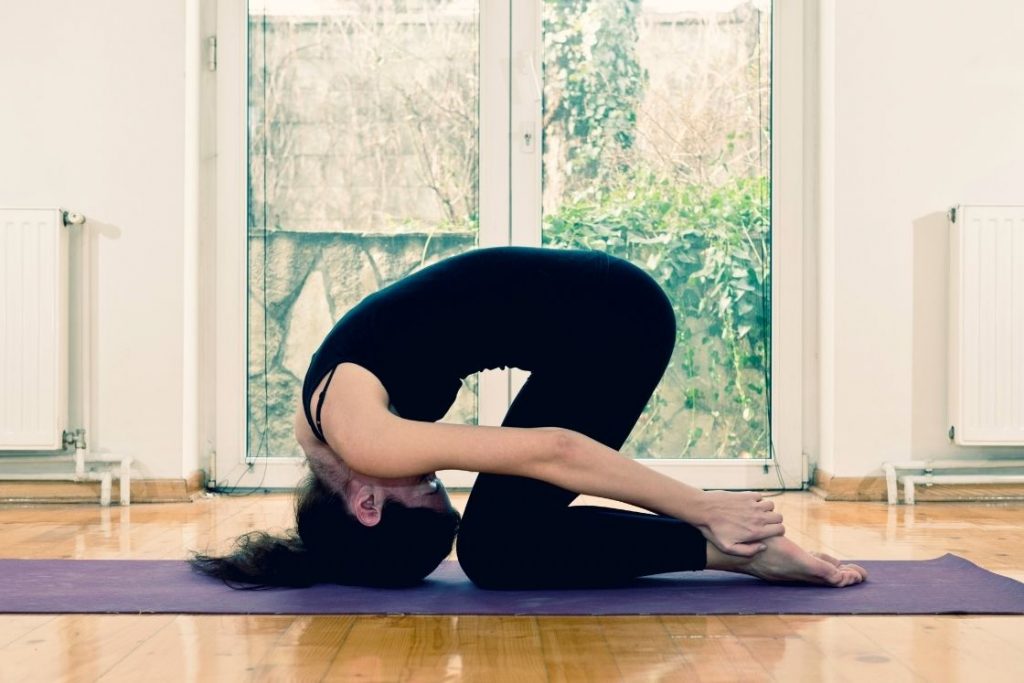
Precautions & Contraindications
- Avoid rabbit pose in case of any injury in the neck, back, shoulders, and arms.
- People with spondylitis must not practice the pose.
- Hypertension patients & Pregnant women must avoid its practice.
- If you have depression or vertigo, this pose is certainly not recommended.
Preparatory poses
- Hero Pose (Virasana)
- Child Pose (Balasana)
- Camel Pose (Ustrasana)
- Table Top Pose (Bharmanasana)
How to Do Rabbit Pose (Steps)
- Begin with performing the child pose.
- Slowly bring your hands back to hold the heels.
- Draw your forehead towards the knee as close as possible.
- Firm the grip on the heels.
- Inhale, lifting your hips off the heels and rolling on to the top of your head.
- Keep breathing stretching the arms on the heels and the neck without straining it.
- Hold the pose for 30-60 seconds.
- Exhale, bringing the hips to the heels and releasing the hands forward.
- Relax in child’s pose.
Keeping a folded blanket under the head and knees can be a relaxing modification for rabbit pose. It reduces the pressure on the knees and head while maintaining the stretch.
Follow-up Poses
- Cobra Pose (Bhujangasana)
- Lion Pose (Simhasana)
- Tabletop position (Bharmanasana)
Variations
- Rabbit Pose arm variation – From the rabbit pose, take your hands from the heels and slowly bring them forward. Clasp the hands keeping the arms stretched out.
- Balancing on knees and head – Keep the crown of the head firmly on the ground. Lift the feet towards the ceiling shifting weight to the knees and head. Wrap your hands around your ankles pressing the heels against the hips.
- Advanced variation – After attaining the rabbit pose take your hands from your heels and straight them behind your back, palms facing the floor. Move further with bringing the shoulders to the knees. The head then lies in the space created between the knees.
- Simple variation- Beginners can perform this variation. Start with sitting in vajrasana. Inhale raising your arms up with open arms arch a little, shift your focus to your hands. With an exhalation bending forward stretching the arms forward with palms and forehead on the floor.
Therapeutic Applications
Rabbit pose is most beneficial and can cure the the following conditions;
- It is a pose that brings calmness to the mind by enhancing the blood flow. Hence proved beneficial in treating depression and anxiety. [efn_note] Effectiveness of Yoga on Trait Anxiety Level among Adolescent Students https://files.eric.ed.gov/fulltext/EJ1184167.pdf [/efn_note]
- As rabbit pose is an inversion posture, holding this pose for a few minutes increases the blood flow to the scalp. It makes this pose a very good exercise for hair growth.
- People suffering from diabetes can get benefits from rabbit pose. Rounding trunk stimulates the insulin hormone secretion in this pose.
- It is even recommended to cure insomnia and improve sleep patterns.
- In the issue like sinuses, cold, or tonsillitis improvements can be observed by practicing sasangasana.
- Back pain and lower back stiffness are also relieved by this pose.
Rabbit Pose Benefits
1. Strengthens spine
The spine is flexed in the pose, it causes the back muscles to relieve tension. The spine is actively engaged in the process and rhythmic breathing helps to lengthen it and increasing its strength.
2. Relieves tension from upper body
The arms are stretched along with shoulders and back. The neck is also curved lengthening the spine from the crown. Therefore, any tension trapped in these regions is released by practicing the rabbit pose.
3. Improves blood circulation
The inversion involved in the rabbit pose enhances the blood flow to the brain. Also, the supply of fresh oxygen to the muscles involved enhances the blood circulation of the body.
4. Regulates the hormonal balance
The stretch involved in the neck stimulates the thyroid gland. It maintains the proper hormonal balance and builds immunity by improving metabolism. The hormonal regulation benefits the functioning of the endocrine system.
5. Aids in better digestion
The muscles of the abdomen are also stretched while holding rabbit pose. It tones the abdominal muscles making them stronger. It also stimulates the digestive organs and facilitates the functioning of the digestive system.
